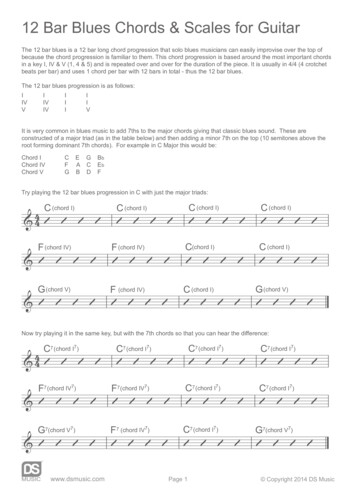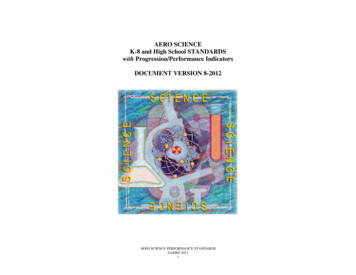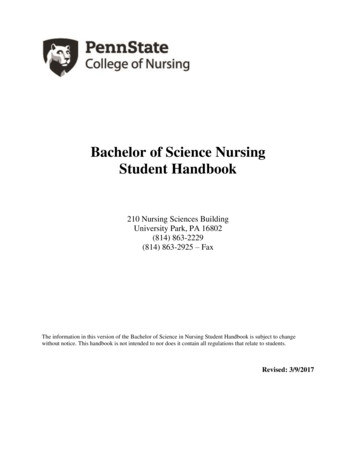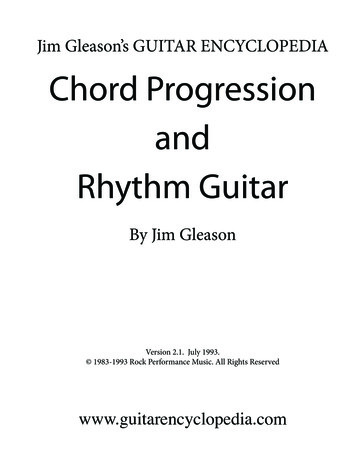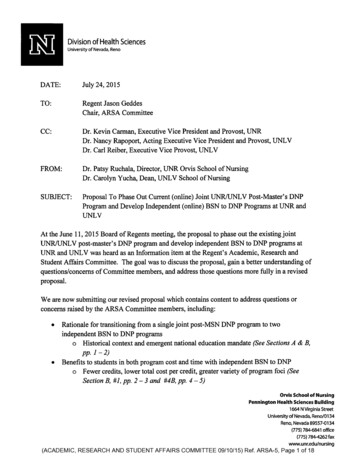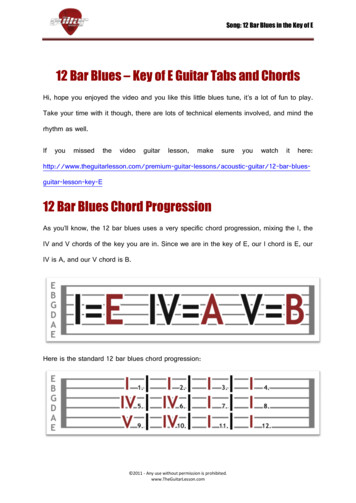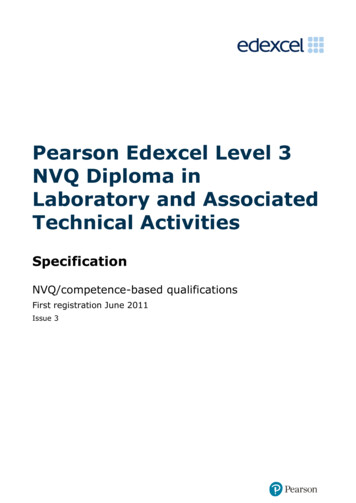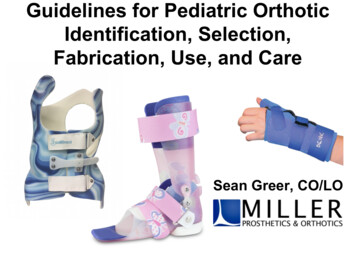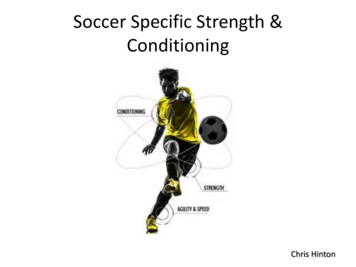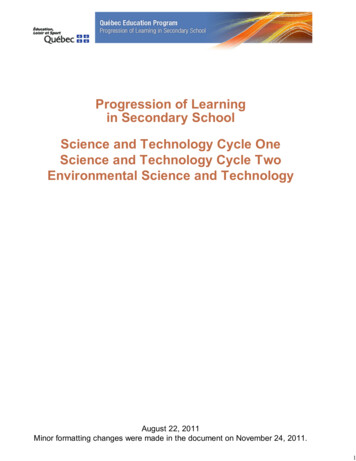
Transcription
Progression of Learningin Secondary SchoolScience and Technology Cycle OneScience and Technology Cycle TwoEnvironmental Science and TechnologyAugust 22, 2011Minor formatting changes were made in the document on November 24, 2011.1
Table of ContentsProgression of Learning in Secondary School3Introduction5The Material World6The Living World18The Earth and Space28The Technological World35Techniques43Strategies47Reproduction rightsEducational institutions are authorized to reproduce this document in whole or in part. If copies are sold, the price mustnot exceed the cost of reproduction. This document is available at:[ www.mels.gouv.qc.ca/progression/secondaire/index en.asp ]2
Progression of Learning in Secondary SchoolThe progression of learning in secondary school constitutes a complement to each school subject, providing furtherinformation on the knowledge that the students must acquire and be able to use in each year of secondary school. Thistool is intended to assist teachers in planning both their teaching and the learning that their students are to acquire.The role of knowledge in learningThe knowledge that young people acquire enables them to better understand the world in which they live. From a veryearly age, within their families and through contact with the media and with friends, they accumulate and learn to use anincreasingly greater body of knowledge. The role of the school should be to progressively broaden, deepen and structurethis knowledge.Knowledge and competencies must mutually reinforce each other. On the one hand, knowledge becomes consolidatedwhen it is used and, on the other hand, the exercise of competencies entails the acquisition of new knowledge. Helpingyoung people acquire knowledge raises the challenging question of how to make this knowledge useful and durable, andthus evokes the notion of competency. For example, we can never be really assured that a grammar rule has beenassimilated until it is used appropriately in a variety of texts and contexts that go beyond the confines of a repetitive,targeted exercise.Intervention by the teacherThe role of the teacher in knowledge acquisition and competency development is essential, and he or she must intervenethroughout the learning process. In effect, the Education Act confers on the teacher the right to “select methods ofinstruction corresponding to the requirements and objectives fixed for each group or for each student entrusted to hiscare.” It is therefore the teacher’s responsibility to adapt his or her instruction and to base it on a variety of strategies,whether this involves lecture-based teaching for the entire class, individualized instruction for a student or a small group ofstudents, a series of exercises to be done, a team activity or a particular project to be carried out.In order to meet the needs of students with learning difficulties, teachers should encourage their participation in theactivities designed for the whole class, although support measures should also be provided, when necessary. These mightinvolve more targeted teaching of certain key elements of knowledge, or they might take the form of other specializedinterventions.As for the evaluation of learning, it serves two essential functions. Firstly, it enables us to look at the students’ learning inorder to guide and support them effectively. Secondly, it enables us to verify the extent to which the students haveacquired the expected learning. Whatever its function, in accordance with the Policy on the Evaluation of Learning,evaluation should focus on the acquisition of knowledge and the students’ ability to use this knowledge effectively incontexts that draw upon their competencies.StructureThe progression of learning is presented in the form of tables that organize the elements of knowledge similarly to the waythey are organized in the subject-specific programs. In mathematics, for example, learning is presented in fields: arithmetic,geometry, etc. For subjects that continue on from elementary school, the Progression of Learning in Secondary Schoolhas been harmonized with the Progression of Learning in Elementary School. Every element of learning indicated isassociated with one or more years of secondary school during which it is formally taught.3
A uniform legend is used for all subjects. The legend employs three symbols: an arrow, a star and a shaded box. What isexpected of the student is described as follows:Student constructs knowledge with teacher guidance.Student applies knowledge by the end of the school year.Student reinvests knowledge.An arrow indicates that teaching must be planned in a way that enables students to begin acquiring knowledge during theschool year and continue or conclude this process in the following year, with ongoing systematic intervention from theteacher.A star indicates that the teacher must plan for the majority of students to have acquired this knowledge by the end of theschool year.A shaded box indicates that the teacher must plan to ensure that this knowledge will be applied during the school year.4
Science and TechnologyGeneral Education PathIntroductionThis document provides additional information about the learning prescribed in the compulsory secondary-level Scienceand Technology programs and its progression from year to year and from cycle to cycle. This document is intended to helpteachers with their lesson planning.To progress in their learning, students need to do more than merely acquire knowledge. They must also learn to applytheir knowledge in a variety of increasingly complex situations. By appropriately using the knowledge, techniques andstrategies listed in this document, they will develop the competencies outlined in the Science and Technology programs.By applying these competencies, they will acquire new knowledge which, in turn, will help them further develop theircompetencies.In order to seek answers or solutions to scientific and technological problems (Competency 1), students must becomefamiliar with strategies and acquire conceptual and technical knowledge that will enable them to define a problem, exploreit and then justify their methodological choices and results. Similarly, the appropriate scientific or technological conceptsand principles can help them understand phenomena, explain the operation of objects or form an opinion and,consequently, make the most of their scientific and technological knowledge (Competency 2). Finally, in order tocommunicate in the languages used in science and technology (Competency 3), they must have knowledge that willenable them to interpret and convey messages using the languages and types of representation associated with scienceand technology.In elementary school, students became familiar with science and technology and explored knowledge involving simple andusually observable phenomena in their immediate environment. In secondary school, they further develop their scientificand technological literacy and continue to do so throughout their lives. In Cycle One, students learn about naturalphenomena and man-made objects that interest them. In Cycle Two, the compulsory concepts are organized around twothemes: The Human Organism in Secondary III and The Environment in Secondary IV. In the optional EnvironmentalScience and Technology program, the knowledge to be acquired is organized around three environmental issues, two ofwhich are new. Successful completion of this program will make it easier to enroll in the optional Physics and Chemistryprograms offered in Secondary V.The tables in this document outline the knowledge related to each of the four areas of the programs: The Material World,The Living World, The Earth and Space, and The Technological World. Each table is preceded by a text explaining howthis knowledge contributes to students' learning in science and technology. Each section begins with a short textdescribing the related knowledge that was acquired at the elementary level.1 Two other tables provide information aboutthe appropriate techniques and strategies for students to use.The concepts are further clarified by a list of statements indicating the degree of complexity of the subject matter targetedand explanations of the progression of learning from one year to the next. In some cases, specifications about the extent ofthe knowledge to be addressed appear in parentheses.1. Elementary school teachers can choose themes from among those listed in the program. It is therefore possible thatsome students may not have studied certain concepts, even though the concepts mentioned here should have beenaddressed at the elementary level. The table of strategies includes a column devoted to learning acquired in elementaryschool.5
Science and TechnologyGeneral Education PathThe Material WorldIn The Material World, students acquire scientific and technological knowledge pertaining to the organization of the worldaround us, the elements that compose it and the forces that govern it.In secondary school, students explore increasingly complex phenomena and technical objects and seek answers andsolutions to a variety of problems. They acquire scientific knowledge about The Material World that helps them understandand explain the factors at play in different scientific issues and in the operation of technological objects, systems andprocesses. This knowledge, along with the knowledge they acquire in other areas of the program, enables them tounderstand scientific models, theories and laws. Students refine their understanding of the concepts related to TheMaterial World by using the experimental method, technological analysis and the technological design process.In Secondary III, knowledge in this area is organized around the problem-solving process and the analysis and design oftechnical objects pertaining to the human organism, which enables students to make connections with knowledge from TheLiving World. In Secondary IV, students continue to construct their scientific and technological knowledge by exploring lawsand models related to environmental issues.Student constructs knowledge with teacher guidance.SecondaryStudent applies knowledge by the end of the school year.Student reinvests knowledge.Statements preceded by the symbol indicate knowledge specific to the compulsory Science andTechnology program. Most of these statements are, however, found in the progression of learning for theoptional Science and the Environment program.A. entary schoolStudents recognize and describe the external characteristics of an object and the materials of which it is made. Theycompare the mass and volume of solids and liquids. They use a thermometer and associate temperature changes withdifferent contexts. They can tell the difference between three states of matter (solid, liquid, gas) and describe theoperations required to move from one to the other (heating, cooling).Secondary school1. Properties of matterSTSTESTa. Massi. Defines the concept of massii. Compares the mass of different substances with the same volumeb. Volumei. Defines the concept of volumeii. Chooses the appropriate unit of measurement to express volume (e.g. 120 mLor 0.12 L or 120 cm3)iii. Compares the volume of different substances with the same massc. Temperaturei. Describes the effect of heat on the degree of agitation of particlesii. Defines temperature as a measurement of the degree of agitation of particlesiii. Explains the thermal expansion of bodies6
d. States of matteri. Names the different phase changes of matter (vaporization, condensation,freezing, melting, deposition, sublimation)1ii. Interprets the phase change diagram for a pure substancee. Acidity/alkalinityi. Determines the observable properties of acidic, basic or neutral solutions(e.g. reaction to litmus, reactivity with metals)ii. Determines the acidity or alkalinity of common substances (e.g. water, lemonjuice, vinegar, soft drinks, milk of magnesia, cleaners)f. Characteristic propertiesi. Defines a characteristic property as a property that aids in the identification ofa substance or group of substancesii. Identifies groups of substances based on their common characteristicproperties (e.g. acids turn litmus red)iii. Associates a characteristic property of a substance or material with its use(e.g. metal is used to make pots because it is a good conductor of heat)2. Characteristic physical propertiesSTSTESTSTSTESTa. Melting pointi. Identifies a substance by its melting point using a reference documentb. Boiling pointi. Identifies a substance by its boiling point using a reference documentc. Densityi. Explains the concept of densityii. Determines the density of different substancesiii. Identifies liquid and solid substances by their density using a referencedocumentd. Solubilityi. Defines the concept of solubilityii. Describes the effect of variations in temperature on the solubility of asubstance3. Properties of solutionsa. Solutions2i. Describes the properties of an aqueous solution (e.g. only one visible phase,translucent)b. Solutei. Recognizes the solute in a given aqueous solutionc. Solventi. Recognizes the solvent in a given aqueous solution (e.g. lymph, tears, cellplasma, urine)d. Concentrationi. Defines the concept of the concentration of a solution7
ii. Describes the effect of variations in the quantity of solute or solvent on asolution's concentrationiii. Determines the concentration of an aqueous solution (g/L or percentage)iv. Determines the concentration of an aqueous solution (g/L, percentage orppm)v. Determines the concentration of an aqueous solution (g/L, percentage, ppm,mol/L)e. Electrolytesi. Defines the concept of electrolytef. Strength of electrolytesi. Qualitatively speaking, associates the strength of an electrolyte with itsdegree of dissociationg. pH scale3i. Describes the pH scale (acidity, alkalinity, neutrality, increasing anddecreasing values)ii. Determines the pH of a few common substances (e.g. distilled water,rainwater, saliva, lemon juice, cleaners)h. Electrolytic dissociationi. Describes electrolytic dissociationi. Ionsi. Defines the concept of ionj. Electrical conductivityi. Describes the mechanism that allows aqueous solutions to conduct electricity(electrolytic dissolution of a solute, formation of mobile ions)4. Characteristic chemical propertiesSTSTESTa. Reaction to indicatorsi. Recognizes a substance by its characteristic chemical properties (e.g. starchturns blue in the presence of an iodine solution, acidic solutions turnbromothymol blue yellow)B. Changes12344Elementary schoolStudents demonstrate that the properties of matter do not change during physical changes (e.g. distortion, breaking,crushing), but that they do change during chemical changes (e.g. cooking, combustion). They recognize that the quantityof matter is conserved during physical changes (e.g. mass of a piece of chalk whether whole or crushed). They becomefamiliar with how certain household products are made (e.g. soap, paper, maple syrup).Secondary school1. Changes in matterSTSTESTa. Conservation of matteri. Demonstrates that matter is conserved during a chemical change(e.g. conservation of mass in a precipitation reaction)b. Mixturesi. Describes the properties of a mixture (e.g. made up of several substances,one or more phases)ii. Distinguishes between a solution or homogenous mixture (e.g. drinking water,air, alloy) and a heterogeneous mixture (e.g. tomato juice, smog, rock)8
c. Solutions4d. Separation of mixturesi. Associates a separation technique with the type of mixture to be separated5ii. Describes the steps involved in separating a complex mixture(e.g. sedimentation, decantation and evaporation to separate salt water andsand)e. Particle modeli. Defines the particle model as a means of representing the behaviour of matterii. Describes the particle model in terms of the qualities and limitations of ascientific model2. Physical changesSTSTESTSTSTESTa. Physical changesi. Describes the characteristics of a physical change (e.g. substance retains itsproperties, molecules remain intact)ii. Recognizes different physical changes (e.g. phase changes, preparation orseparation of a mixture)b. Dissolutioni. Explains dissolution using the particle modelc. Dilutioni. Explains dilution in terms of concentration and volumeii. Determines the final volume or concentration of an aqueous solution afterdilution (e.g. when the volume of solvent is doubled, the concentration of thesolution decreases by half)d. Phase changesi. Compares the arrangement of particles in a substance in a solid, liquid orgaseous formii. Explains phase changes using the particle model3. Chemical changesa. Chemical changesi. Describes the indicators of a chemical change (formation of a precipitate,effervescence, colour change, heat, light)ii. Explains a chemical change based on the changes in the properties of thesubstances involvediii. Names different types of chemical changes (e.g. decomposition, oxidation)iv. Names chemical changes that occur in the human body (e.g. respiration,digestion)b. Decomposition and synthesisi. Represents a decomposition or synthesis reaction using the particle modelii. Associates known chemical reactions with decomposition or synthesisreactions (e.g. respiration, photosynthesis, combustion, digestion)c. Oxidationi. Represents an oxidation reaction using the particle model9
ii. Associates known chemical reactions with oxidation reactions(e.g. combustion, corrosion)iii. Associates a chemical equation in which oxygen is one of the reactants withone of the possible cases of an oxidation reactiond. Precipitationi. Describes the visible manifestation of precipitation (formation of a soliddeposit when two aqueous solutions are mixed)ii. Represents a precipitation reaction using the particle modele. Combustioni. Describes the perceivable manifestations of rapid combustion (e.g. heat, light)ii. Explains a combustion reaction using the fire trianglef. Photosynthesis and respiration6g. Acid-base neutralization reactioni. Gives examples of acid-base neutralization reactions (e.g. adding lime toneutralize the acidity of a lake)ii. Names the products formed during acid-base neutralization (salt and water)iii. Recognizes an acid-base neutralization from its equationh. Saltsi. Determines the molecular formula of the salt produced by the neutralization ofa given acid and a given basei. Types of bondsi. CovalentDefines a covalent bond as a bond resulting from a sharing of electronsMakes a schematic representation of a covalent bondIdentifies molecules that feature a covalent bond (e.g. N2, CO2)ii. IonicDefines an ionic bond as a bond resulting from the gain or loss ofelectronsMakes a schematic representation of an ionic bondIdentifies molecules that feature an ionic bond (e.g. NaCl, NH4OH)Associates an ionic bond with an electrolytic substancej. Law of conservation of massi. Explains the law of conservation of mass during a chemical reactionii. Represents the conservation of mass using the particle modelk. Balancing chemical equationsi. Balances chemical equationsl. Stoichiometryi. Determines the quantities of reactants or products using stoichiometriccalculations (gram or mole)10
m. Endothermic and exothermic reactionsi. Distinguishes an endothermic reaction from an exothermic reaction accordingto perceptible signs (e.g. temperature variations, emission of light)ii. Distinguishes an endothermic reaction from an exothermic reaction accordingto the position of the energy term in the chemical equation4. Nuclear changes7STSTESTSTSTESTa. Nuclear stabilityi. Explains nuclear stability as the case where the nucleus of the atom is heldtogether by an optimal number of neutronsb. Radioactivityi. Defines radioactivity as the emission of particles or energy by the nuclei ofatoms following nuclear transformationsii. Associates the use of radioactivity with technological applications(e.g. radiotherapy, dating)c. Fission and fusioni. Distinguishes nuclear fission from nuclear fusion5. Transformation of energy8a. Forms of energyi. Describes different forms of energy (chemical, thermal, mechanical, radiation)ii. Identifies the forms of energy involved in a transformation (e.g. electrical tothermal in a toaster, electrical to radiation in an infrared lamp)iii. Defines joule as the unit of measurement for energyb. Law of conservation of energyi. Explains qualitatively the law of conservation of energyii. Applies the law of conservation of energy in different contextsc. Energy efficiencyi. Defines the energy efficiency of a device or system as the proportion ofenergy consumed that is transformed into effective work (amount of usefulenergy / amount of energy consumed x100)ii. Explains how to improve the energy efficiency of an electrical applianced. Distinction between heat and temperature9i. Describes heat as a manifestation of energyii. Describes the relationship between heat and temperaturee. Relationship between thermal energy, specific heat capacity, mass and temperature variationi. Describes qualitatively the relationship between the change in thermal energy(quantity of heat) of a substance, its mass, its specific heat capacity and thevariations in temperature to which it is exposedii. Applies the mathematical relationship between thermal energy, mass, specificheat capacity and temperature variation (ΔE Q mcΔT)f. Effective forcei. Defines effective force as the component of the applied force parallel to thedirection of travel11
ii. Determines graphically the magnitude of the effective force in a givensituationg. Relationship between work, force and distance travelledi. Describes qualitatively the relationship between the work done, the forceapplied on a body and the distance travelled by the bodyii. Applies the mathematical relationship between work, effective force anddistance travelled (W FΔd)h. Relationship between mass and weighti. Describes qualitatively the relationship between mass and weightii. Applies the mathematical relationship between mass and weight (Fg mg)i. Relationship between potential energy, mass, acceleration and distance travelledi. Describes qualitatively the relationship between the potential energy of abody, its mass, its gravitational acceleration and the distance it travelsii. Applies the mathematical relationship between potential energy, mass,gravitational acceleration and the distance travelled (Ep mgh)j. Relationship between kinetic energy, mass and speedi. Describes qualitatively the relationship between the kinetic energy of a body,its mass and its speedii. Applies the mathematical relationship between kinetic energy, mass andspeed (Ek ½mv2)k. Relationship between work and energy10i. Describes qualitatively the relationship between the work done on a body andthe variation in energy within that bodyii. Applies the mathematical relationship between work and energy (W ΔE)C. Organization12344Elementary schoolStudents classify objects or substances based on their properties, and living organisms based on their physicalcharacteristics. They use the common names for certain substances (e.g. water, carbon dioxide, oxygen) when studyingphotosynthesis and respiration.Secondary school1. Structure of matterSTSTESTa. Atomi. Describes Dalton's atomic modelii. Defines the atom as the basic unit of the moleculeb. Moleculei. Describes a molecule using Dalton's atomic model (combination of atomslinked by chemical bonds)ii. Represents the formation of a molecule using Dalton's atomic modelc. Elementi. Defines an element as a pure substance made of a single type of atom(e.g. Fe, N2)d. Periodic tablei. Describes the periodic table as a structured classification of elements12
e. Pure substancei. Defines a pure substance as a substance made up of a single type of atom ormoleculeii. Distinguishes between elements (e.g. iron, dioxygen, sodium) and compounds(e.g. water, carbon dioxide, glucose)f. Homogeneous and heterogeneous mixtures11i. Describes homogeneous and heterogeneous mixtures in the human body(e.g. lymph, blood, urine)g. Groups and periodsi. Locates the groups and periods in the periodic tableii. Describes the common characteristics of a group (e.g. number of valenceelectrons, chemical reactivity)iii. Associates the number of electron shells in an element with the number of itsperiodh. Rutherford-Bohr atomic modeli. Describes the Rutherford-Bohr atomic modelii. Represents atoms using the Rutherford-Bohr modeli. Neutroni. Describes the position and electrical charge of the neutron in an atomj. Simplified atomic modeli. Represents an atom of a given element using the simplified atomic modelk. Lewis notationi. Determines the number of valence electrons in an elementii. Represents atoms using Lewis notationl. Nomenclature and notation rulesi. Applies nomenclature and notation rules to name the molecule or write themolecular formula of binary compoundsm. Polyatomic ionsi. Recognizes the common polyatomic ions (e.g. NH4 , OH-, NO3-, CO32-,SO42-, PO43-) by their name, their formula or their compositionn. Concept of the molei. Defines the mole as the unit of measure of the amount of a substanceii. Expresses an amount of a substance in moleso. Avogadro’s numberi. Expresses a quantity of particles using Avogadro’s number2. Periodic classificationSTSTESTa. Atomic numberi. Associates the atomic number of an element with the number of protons it has13
b. Isotopes12i. Defines isotopes as atoms of the same element whose nuclei have differentnumbers of neutrons and therefore different atomic massesii. Defines a radioactive isotope as an isotope whose atomic nucleus is unstablec. Relative atomic massi. Explains qualitatively the concept of relative atomic massd. Periodicity of propertiesi. Describes the periodicity of certain properties of elements (e.g. chemicalreactivity, atomic radius, electronegativity)D. Fluids1234412344Elementary schoolStudents distinguish between three states of matter: solid, liquid and gas.Secondary schoola. Pressurei. Defines pressure as the force exerted by particles when they collide with aconstricting surfaceii. Describes qualitatively the main factors that affect the pressure exerted by afluidb. Compressible and incompressible fluidsi. Distinguishes between compressible and incompressible fluidsii. Names compressible fluids (e.g. air) and incompressible fluids (e.g. blood) inthe human bodyiii. Explains how fluids move around in the human body, using the concept ofpressurec. Relationship between pressure and volumei. Qualitatively describes the relationship between the pressure and volume of agas (e.g. inhaling and exhaling, bicycle pump)E. WavesElementary schoolStudents associate sunlight with a source of energy.Secondary schoola. Frequencyi. Defines the frequency of a wave as the number of cycles per second (Hz)ii. Associates the frequency of a sound wave with the pitch of the sound(e.g. a low-frequency wave produces a low-pitched sound)b. Wavelengthi. Defines wavelength as the distance between two identical points on a waveat a given time (e.g. distance between crests)ii. Describes the relationship between wavelength and energy (e.g. X-rays,which are high-energy waves, have a short wavelength)c. Amplitudei. Defines the amplitude of a sound wave as the loudness of the soundd. Decibel scale14
i. Locates on the decibel scale levels dangerous to the human ear based onduration or frequency of exposuree. Electromagnetic spectrumi. Locates different areas on the electromagnetic spectrum (e.g. radio waves,visible light, X-rays)ii. Describes different applications of electromagnetic waves in the health caresector (e.g. X-rays, infrared optical imaging)f. Deviation of light wavesi. Describes how light rays are deviated by a plane reflective surfaceii. Determines the angle of reflection of a light ray on the surface of a planemirroriii. Describes how light rays are deviated when they pass through the surface ofa translucent substanceg. Focal point of a lensi. Determines the focal point of concave and convex lensesii. Describes the relationship between the focal point of a lens and the degree ofdeviation of light rays in different situations (e.g. accommodation of thecrystalline lens, choice of corrective lenses)F. Electricity and electromagnetism12344Elementary schoolStudents name the components of a simple electrical circuit (wire, power source, bulb, switch) and describe theirfunction. They recognize the effects of magnetism in magnets (attraction and repulsion).Secondary school1. ElectricitySTSTESTa. Electrical chargei. Associates elementary particles with their electrical chargeii. Describes the behaviour of electrical charges of opposite signs or of the samesign when close togetherb. Static electricityi. Describes static electricity as the transfer of electrons from one body toanotherc. Ohm's lawi. Describes qualitatively the relationship between voltage, resistance andcurrent intensity in an electrical circuitii. Applies the mathematical relationship between voltage, resistance and currentintensity in an electrical circuit (V RI)d. Electrical circuitsi. Describes the function of different elements of an electrical circuit (e.g. thewires transmit electrons along the circuit, resistors transform electrical energyinto another form of energy)13ii. Describes the two types of connections in electrical circuits (series, parallel)iii. Distinguishes between alternating and direct currentiv. Represents a simple electrical circuit using a diagrame. Relationship between power and electrical energyi. Applies the mathematical relationship between power, voltage and currentintensity in an electrical circuit (P VI)15
ii. Describes qualitatively the relationship between the power of an electricalappliance, the electrical energy it consumes and the amount of time it is inoperationiii. Applies the mathematical relationship between electrical energy co
The tables in this document outline the knowledge related to each of the four areas of the programs: The Material World, The Living World, The Earth and Space, and The Technological World. Each table is preceded by a text explaining how this knowledge contributes to students' learning in science
